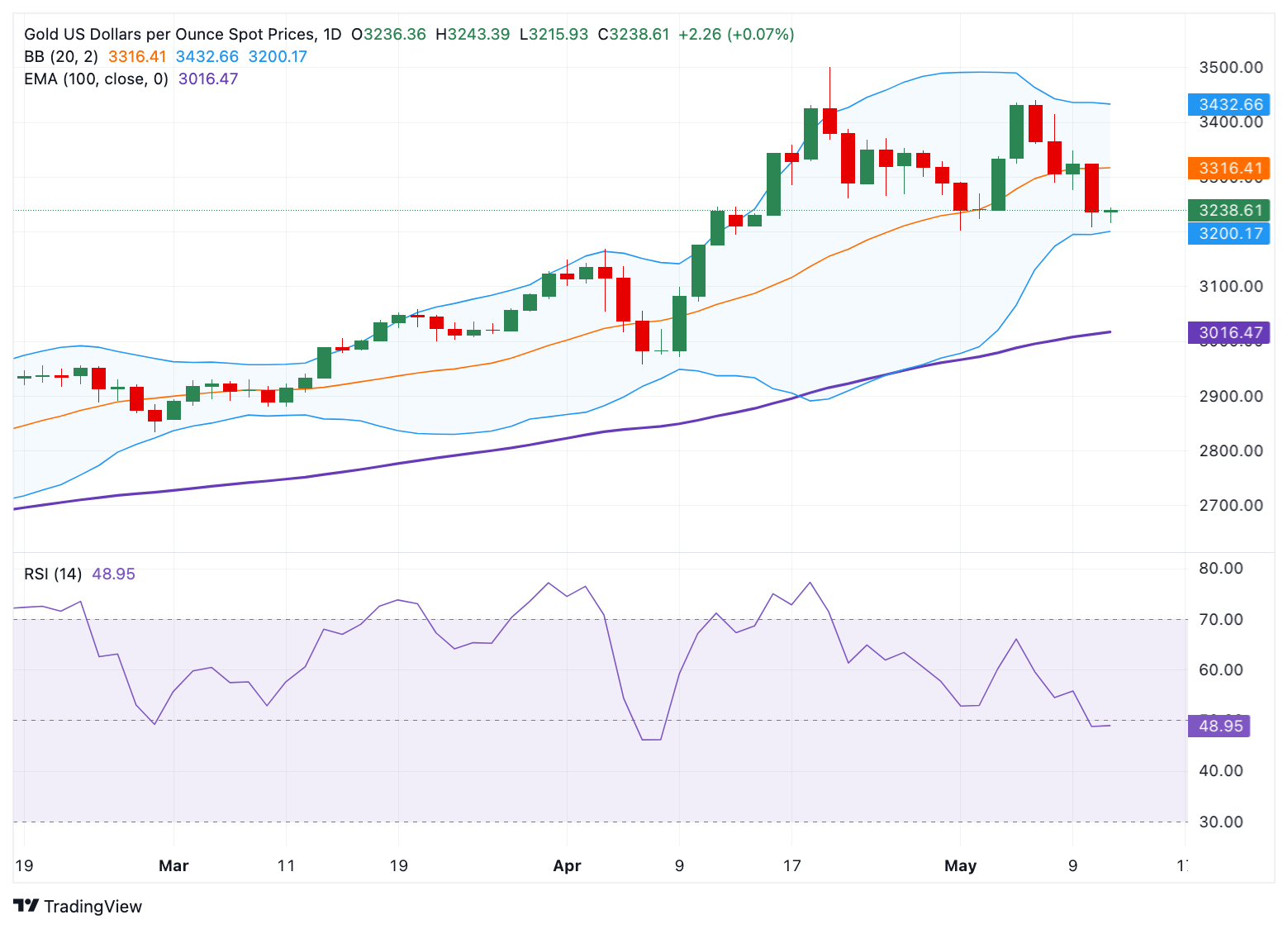Gold price edges lower as US, China agree to reduce tariffs, eyes on US CPI data
- Gold price trades in negative territory around $3,235 in Tuesday’s Asian session.
- US and China agreed to de-escalate their trade war by lowering import tariffs on each other's goods for 90 days.
- Traders brace for the US April CPI inflation report, which is due later on Tuesday.
The Gold price (XAU/USD) edges lower to around $3,235 during the early Asian session on Tuesday. The precious metal remains on the defensive due to a stronger US Dollar (USD), higher US yields, and optimism on the US-China trade deal. Later on Tuesday, traders will take more cues from the US April Consumer Price Index (CPI) report.
Improved risk sentiment following the announcement of a temporary deal between the United States (US) and China to reduce tariffs has weighed on the safe-haven asset, like the Gold price. The US will cut extra tariffs it imposed on Chinese imports in April this year to 30% from 145%, and Chinese duties on US imports will be reduced to 10% from 125%. The fresh measures are effective for 90 days.
"The de-escalation of tensions between China and the US is reducing the demand for safe haven assets like gold," said Giovanni Staunovo, analyst at Swiss bank and London bullion clearer UBS.
Gold traders brace for the US CPI inflation data on Tuesday, which might offer some hints about the US Federal Reserve's (Fed) policy path. The headline CPI is expected to show an increase of 2.4% YoY in April, while the core CPI is projected to show a rise of 2.8% YoY in the same report period.
Swap markets have priced in the Fed’s first 25 basis points (bps) rate cut for the September meeting, and they expect two additional rate reductions towards the end of the year. Last week, they indicated three cuts this year, with a change likely as soon as July.
India’s Prime Minister Narendra Modi said on Monday that operations against Pakistan have only been kept in abeyance, and the future will depend on their behaviour. Meanwhile, Ukrainian President Volodymyr Zelensky noted he is prepared to meet Russian President Vladimir Putin this week, shortly after Trump urged him to “immediately” accept the Russian leader’s offer to hold peace talks in Turkey. Any signs of escalating geopolitical tensions could boost the safe-haven flows, benefiting the yellow metal.
Gold price retains positive bias in the longer term
Gold price trades on a negative note on the day. According to the daily timeframe, the constructive outlook of the precious metal remains intact, characterized by the price holding above the key 100-day Exponential Moving Average. However, further consolidation ot temporary sell-off cannot be ruled out as the 14-day Relative Strength Index (RSI) is located below the midline.
On the bright side, the first upside barrier to watch is $3,347, the high of May 9. Any follow-through buying above this level could pave the way to $3,432, the upper boundary of the Bollinger Band. Further north, the next hurdle is seen at the all-time high of $3,500.
In the bearish case, the $3,200 psychological level acts as an initial support level for XAU/USD. The additional downside filter emerges at $3,142, the high of April 2.

Tariffs FAQs
Tariffs are customs duties levied on certain merchandise imports or a category of products. Tariffs are designed to help local producers and manufacturers be more competitive in the market by providing a price advantage over similar goods that can be imported. Tariffs are widely used as tools of protectionism, along with trade barriers and import quotas.
Although tariffs and taxes both generate government revenue to fund public goods and services, they have several distinctions. Tariffs are prepaid at the port of entry, while taxes are paid at the time of purchase. Taxes are imposed on individual taxpayers and businesses, while tariffs are paid by importers.
There are two schools of thought among economists regarding the usage of tariffs. While some argue that tariffs are necessary to protect domestic industries and address trade imbalances, others see them as a harmful tool that could potentially drive prices higher over the long term and lead to a damaging trade war by encouraging tit-for-tat tariffs.
During the run-up to the presidential election in November 2024, Donald Trump made it clear that he intends to use tariffs to support the US economy and American producers. In 2024, Mexico, China and Canada accounted for 42% of total US imports. In this period, Mexico stood out as the top exporter with $466.6 billion, according to the US Census Bureau. Hence, Trump wants to focus on these three nations when imposing tariffs. He also plans to use the revenue generated through tariffs to lower personal income taxes.



